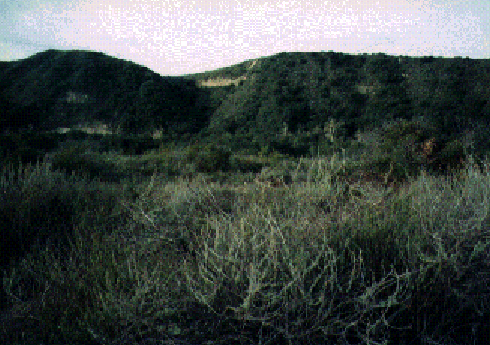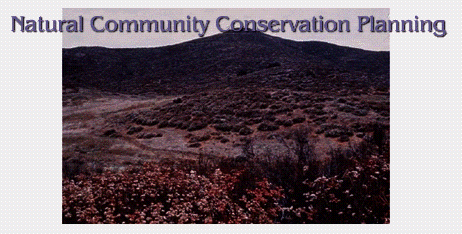

.
The following has been added by the Electronic Desktop Project:
If you are an educator who is using our NEXTSTEP or virtual applications in the classroom, we would especially like to hear from you. Let us know what you are doing and how it is working out. Continued support for this project will depend on its impact in science education.
If you are an educator who is interested in making use of our NEXTSTEP or virtual applications, please let us know how we can help.
 What is Coastal Sage Scrub and Where is it Found?
What is Coastal Sage Scrub and Where is it Found?
 COASTAL SAGE SCRUB is an interesting and complex assemblage of plants and animals and is one of two dominant shrubland vegetation types that occur in Southern California. Its DISTRIBUTION ranges from just south of San Francisco down into northern Baja.
COASTAL SAGE SCRUB is an interesting and complex assemblage of plants and animals and is one of two dominant shrubland vegetation types that occur in Southern California. Its DISTRIBUTION ranges from just south of San Francisco down into northern Baja.
 Coastal sage scrub is usually found at elevations below 1800 feet. It generally occurs in a mosaic pattern across the landscape, along with chaparral ( CLICK HERE for a humorous but informative look at chaparral) and GRASSLANDS.
Coastal sage scrub is usually found at elevations below 1800 feet. It generally occurs in a mosaic pattern across the landscape, along with chaparral ( CLICK HERE for a humorous but informative look at chaparral) and GRASSLANDS.
 Coastal sage scrub derives its name from the California sagebrush which is the most common and widespread plant in the community. Other common species include:
Coastal sage scrub derives its name from the California sagebrush which is the most common and widespread plant in the community. Other common species include:
 If you would like to experience it up close and personal, there are several places in the Los Angeles area where you can go to see it (remember to stop and smell the sage):
If you would like to experience it up close and personal, there are several places in the Los Angeles area where you can go to see it (remember to stop and smell the sage):
 How is Coastal Sage Scrub Being Threatened?
How is Coastal Sage Scrub Being Threatened? The threats to coastal sage scrub fall into three basic catagories:
The threats to coastal sage scrub fall into three basic catagories:
 Along with the habitat in general, there are also many plants and animals that are threatened or ENDANGERED. More than 100 species associated with coastal sage scrub have been listed under the ENDANGERED SPECIES ACT.
Along with the habitat in general, there are also many plants and animals that are threatened or ENDANGERED. More than 100 species associated with coastal sage scrub have been listed under the ENDANGERED SPECIES ACT.
 Can you guess which of the following species are threatened or endangered?
Can you guess which of the following species are threatened or endangered?
 COASTAL CALIFORNIA GNATCATCHER
COASTAL CALIFORNIA GNATCATCHER
 How is Coastal Sage Scrub Being Protected?
How is Coastal Sage Scrub Being Protected? In the past, conservation efforts focussed on using ENVIRONMENTAL LAWS to gain protection for individual species. Although this process did protect some species, it did little to protect the community as a whole. Fortunately, there is now a new approach which seeks to protect the community and all of its inhabitants.
In the past, conservation efforts focussed on using ENVIRONMENTAL LAWS to gain protection for individual species. Although this process did protect some species, it did little to protect the community as a whole. Fortunately, there is now a new approach which seeks to protect the community and all of its inhabitants.

 NCCP is a new program designed to target specific habitats which contain many threatened and endangered species. It is an attempt to prevent future listings by bringing conservationists, developers and local governments together in the development planning process.
NCCP is a new program designed to target specific habitats which contain many threatened and endangered species. It is an attempt to prevent future listings by bringing conservationists, developers and local governments together in the development planning process.
 This approach is meant to be a compromise which preserves habitat and species while allowing development in less sensitive areas.
This approach is meant to be a compromise which preserves habitat and species while allowing development in less sensitive areas.
 For more information on the NCCP, check out these Web sites:
For more information on the NCCP, check out these Web sites:
 Want More Information?
Want More Information? Click on the following links:
Click on the following links:
Please take a few minutes to send us your comments and suggestions. We read every message and try to respond promptly to questions. Your feedback will help us improve our project. Contact Us
Contact UsOther Places To Go
 Return to the Electronic Desktop Project home page
Return to the Electronic Desktop Project home page![]() Check out the WWW Virtual Application Catalog from the EDP
Check out the WWW Virtual Application Catalog from the EDP Check out the NEXTSTEP Application Catalog from the EDP
Check out the NEXTSTEP Application Catalog from the EDP Visit the home page for California State University, Los Angeles
Visit the home page for California State University, Los Angeles